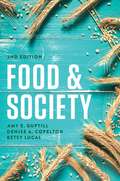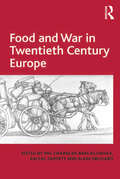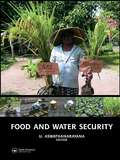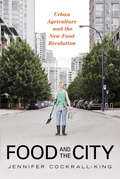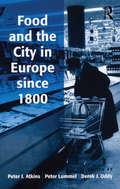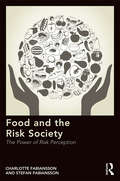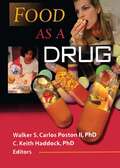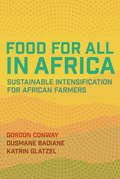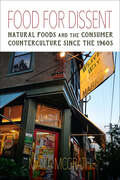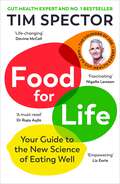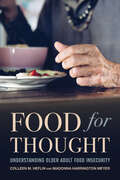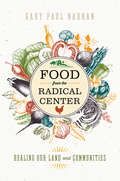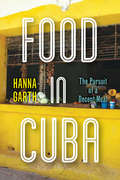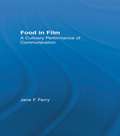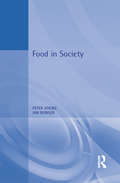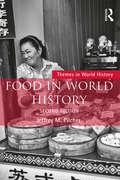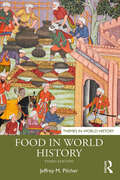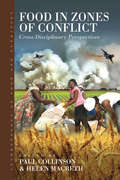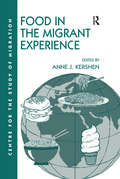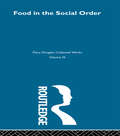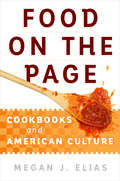- Table View
- List View
Food and Society: Principles and Paradoxes (Second Edition)
by Amy E. Guptill Denise A. Copelton Betsy LucalThis popular and engaging text, now revised in a second edition, offers readers a social perspective on food, food practices, and the modern food system. It engages readers' curiosity by highlighting several paradoxes: how food is both individual and social, reveals both distinction and conformity, and, in the contemporary global era, comes from everywhere but nowhere in particular. With updates and enhancements throughout, the new edition provides an empirically deep, multifaceted, and coherent introduction to this fascinating field. Each chapter begins with a vivid case study, proceeds through a rich discussion of research insights, and ends with discussion questions and suggested resources. Chapter topics include food's role in socialization, identity, health and social change, as well as food marketing and the changing global food system. The new edition gives more focused attention to labor (both paid and unpaid) in all aspects of the food system. In synthesizing insights from diverse fields of social inquiry, the book addresses issues of culture, structure, and social inequality throughout. Written in a lively style, this book will continue to be both accessible and revealing to beginning and intermediate students alike.
Food and Sustainability in the Twenty-First Century: Cross-Disciplinary Perspectives (Anthropology of Food & Nutrition #9)
by Helen Macbeth Paul Collinson Iain Young Lucy AntalSustainability is one of the great problems facing food production today. Using cross-disciplinary perspectives from international scholars working in social, cultural and biological anthropology, ecology and environmental biology, this volume brings many new perspectives to the problems we face. Its cross-disciplinary framework of chapters with local, regional and continental perspectives provides a global outlook on sustainability issues. These case studies will appeal to those working in public sector agencies, NGOs, consultancies and other bodies focused on food security, human nutrition and environmental sustainability.
Food and War in Twentieth Century Europe
by Rachel DuffettWars cannot be fought and sustained without food and this unique collection explores the impact of war on food production, allocation and consumption in Europe in the twentieth century. A comparative perspective which incorporates belligerent, occupied and neutral countries provides new insights into the relationship between food and war. The analysis ranges from military provisioning and systems of food rationing to civilians' survival strategies and the role of war in stimulating innovation and modernization.
Food and Water Security
by U. AswathanarayanaThis book deals with ways and means of managing food and water security in various agroclimatic environments through the integration of R & D, training, people participation, agronomic practices, economic instruments, and administrative policies. It includes contributions by global experts in the field, who elaborate on the governance of f
Food and the City
by Jennifer Cockrall-KingA global movement to take back our food is growing. The future of farming is in our hands--and in our cities.When you're standing in the midst of a supermarket, it's hard to imagine that you're looking at a failing industrial food system. The abundance all around you looks impressive but is really a façade. In fact, there's just a three-day supply of food available for any given city due to complex, just-in-time international supply chains. The system is not only vulnerable, given the reality of food scares, international crises, terrorist attacks, economic upheavals, and natural disasters, but it is also environmentally unsustainable for the long term. As the cold hard facts of peak oil and peak water begin to have an impact, how will we feed a world population of seven billion and growing, most of whom are now urban dwellers? One answer is urban agriculture. This book examines alternative food systems in cities around the globe that are shortening their food chains, growing food within their city limits, and taking their "food security" into their own hands. This award-winning food journalist sought out leaders in the urban-agriculture movement and visited cities successfully dealing with "food deserts." What she found was not just a niche concern of activists but a global movement that cuts across the private and public spheres, economic classes, and cultures. She describes a global movement happening from London and Paris to Vancouver and New York to establish alternatives to the monolithic globally integrated supermarket model. A cadre of forward-looking, innovative people has created growing spaces in cities: on rooftops, backyards, vacant lots, along roadways, and even in "vertical farms." Whether it's a community public orchard supplying the needs of local residents or an urban farm that has reclaimed a derelict inner city lot to grow and sell premium market veggies to restaurant chefs, the urban food revolution is clearly underway and working.This book is an exciting, fascinating chronicle of a game-changing movement, a rebellion against the industrial food behemoth, and a reclaiming of communities to grow, distribute, and eat locally.
Food and the City in Europe since 1800
by Peter LummelThis fascinating volume examines the impact that rapid urbanization has had upon diets and food systems throughout Western Europe over the past two centuries. Bringing together studies from across the continent, it stresses the fundamental links between key changes in European social history and food systems, food cultures and food politics. Contributors respond to a number of important questions, including: when and how did local food production cease to be sufficient for the city and when did improved transport conditions and liberal commercial relations replace local by supra-regional food supplies? How far did the food industry contribute to improved living conditions in cities? What influence did urban consumers have? Food and the City in Europe since 1800 also examines issues of food hygiene and health impacts in cities, looks at various food innovations and how ’new’ foods often first gained acceptance in cities, and explores how eating fashions have changed over the centuries.
Food and the Risk Society: The Power of Risk Perception
by Charlotte Fabiansson Stefan FabianssonThis book offers a comprehensive understanding of the current scientific knowledge concerning risks associated with food preparation, processing and consumption, with particular attention to the gap between scientific research and public perception. Examining the effects of food on the body from both micro and macro levels, it covers a range of broad themes and current concerns, including obesity and the 'obesity epidemic', the benefits or otherwise of dietary supplements, caffeine consumption, GM food, alcohol, organic food, the consumption of fruit and vegetables, and pathogens and contaminants. Thematically arranged according to the application of broad theoretical approaches in sociological theory – the socio-cultural perspective, the risk society perspective and the governmentality perspective – each chapter focuses on a particular area of interest or concern in relation to food, covering the existing literature in detail and offering illustrative empirical examples, whilst identifying gaps in knowledge and areas for further research. An accessible and rigorous examination of food and health, and the discrepancy between scientific opinion and consumer perception of safe food – the real risks versus the perceived risks – this book will appeal to scholars and students of sociology, geography, food, nutrition and environmental ecosystems, as well as health professionals.
Food as a Drug
by Walker S Poston C Keith HaddockFood as a Drug provides psychologists, psychiatrists, and counselors with a unique discussion about possible addictive qualities of some foods to assist clients who are struggling with obesity or eating disorders. Examining the pros and cons of treating eating disorders with an addictions model, this book also explores the tremendous societal and personal costs of eating disorders and obesity, such as increased risk of heart disease, health care costs, and death. Thorough and concise, Food as a Drug will assist you in providing better services to clients with these types of dilemmas.Comprehensive and current, this reference provides information on relevant topics, such as diet and behavior relationships; cross-cultural perspectives on the use of foods for medicinal purposes; regulatory perspectives on drugs, foods, and nutritional supplements; and whether foods have pharmacological properties. Food as a Drug address several important topics, such as: focusing on sugar to determine the effects of food additives on children's behavioral disorders, such as attention deficit disorder and hyperactivity addressing the role that your diet plays on serotonin levels, carbohydrate craving, and depression examining the phenomenological, psychological, and physiological correlations between overeating and how foods may be used to alleviate negative moods discussing the pros and cons of treating obesity and eating disorders with addiction modelsWritten by experts in the field, this book offers you in-depth studies and information about the nature of food as a potentially addictive substance. Food as a Drug will help you understand these difficult-to-treat conditions and offer clients better and more effective services.
Food for All in Africa: Sustainable Intensification for African Farmers
by Ousmane Badiane Gordon Conway Katrin GlatzelAfrica requires a new agricultural transformation that is appropriate for Africa, that recognizes the continent's diverse environments and climates, and that takes into account its histories and cultures while benefiting rural smallholder farmers and their families.In this boldly optimistic book, Sir Gordon Conway, Ousmane Badiane, and Katrin Glatzel describe the key challenges faced by Africa's smallholder farmers and present the concepts and practices of Sustainable Intensification (SI) as opportunities to sustainably transform Africa's agriculture sector and the livelihoods of millions of smallholders. The way forward, they write, will be an agriculture sector deeply rooted within SI: producing more with less, using fertilizers and pesticides more prudently, adapting to climate change, improving natural capital, adopting new technologies, and building resilience at every stage of the agriculture value chain.Food for All in Africa envisions a virtuous circle generated through agricultural development rooted in SI that results in greater yields, healthier diets, improved livelihoods for farmers, and sustainable economic opportunities for the rural poor that in turn generate further investment. It describes the benefits of digital technologies for farmers and the challenges of transforming African agricultural policies and creating effective and inspiring leadership.Food for All in Africa demonstrates why we should take on the challenge and provides ideas and methods through which it can be met.
Food for Dissent: Natural Foods and the Consumer Counterculture Since the 1960s
by Maria McGrathIn the 1960s and early 1970s, countercultural rebels decided that, rather than confront the system, they would create the world they wanted. The natural foods movement grew out of this contrarian spirit. Through a politics of principled shopping, eating, and entrepreneurship, food revolutionaries dissented from corporate capitalism and mainstream America. In Food for Dissent, Maria McGrath traces the growth of the natural foods movement from its countercultural fringe beginning to its twenty-first-century "food revolution" ascendance, focusing on popular natural foods touchstones—vegetarian cookbooks, food co-ops, and health advocates. Guided by an ideology of ethical consumption, these institutions and actors spread the movement's oppositionality and transformed America's foodscape, at least for some. Yet this strategy proved an uncertain instrument for the advancement of social justice, environmental defense, and anti-corporatism. The case studies explored in Food for Dissent indicate the limits of using conscientious eating, shopping, and selling as tools for civic activism.
Food for Life: The New Science of Eating Well, by the Sunday Times bestselling author of SPOON-FED
by Tim Spector'Life-changing' DAVINA McCALL'A must-read' Dr RUPY AUJLA'Fascinating' NIGELLA LAWSON'Empowering' LIZ EARLE**AS HEARD ON THE DIARY OF A CEO PODCAST**Food is our greatest ally for good health, but the question of what to eat in the age of ultra-processed food has never seemed so complicated.Drawing on cutting-edge research and personal insights, Professor Tim Spector offers clear answers in this definitive, easy-to-follow guide to the new science of eating well.Empowering and practical, Food for Life is nothing less than a new approach to how to eat - for our health and the health of the planet.‘No fads, no nonsense, just practical, science-based advice on how to eat well’ Daily Mail, Books of the Year'A rigorously academic book that welcomes the layperson with open arms' The Times** A THE TIMES and SUNDAY TIMES BOOK OF THE YEAR**** WINNER OF THE FORTNUM & MASON SPECIAL AWARD **
Food for Thought: Nourishment, Culture, Meaning (Numanities - Arts and Humanities in Progress #19)
by Amy Bentley Simona StanoThis volume offers new insights into food and culture. Food habits, preferences, and taboos are partially regulated by ecological and material factors - in other words, all food systems are structured and given particular functioning mechanisms by specific societies and cultures, either according to totemic, sacrificial, hygienic-rationalist, aesthetic, or other symbolic logics. This provides much “food for thought”. The famous expression has never been so appropriate: not only do cultures develop unique practices for the production, treatment and consumption of food, but such practices inevitably end up affecting food-related aspects and spheres that are generally perceived as objectively and materially defined. This book explores such dynamics drawing on various theoretical approaches and analytical methodologies, thus enhancing the cultural reflection on food and, at the same time, helping us see how the study of food itself can help us understand better what we call “culture”. It will be of interest to anthropologists, philosophers, semioticians and historians of food.
Food for Thought: Understanding Older Food Insecurity
by Madonna Harrington Meyer Colleen M. HeflinWhile food insecurity among households with children often makes the headlines, a quieter issue that receives much less attention is the food insecurity faced by older adults. In 2023, over nine percent of Americans age sixty and older were food insecure. Without policy intervention, that number is only expected to grow as the U.S. population continues to age. In Food for Thought social policy scholar Colleen M. Heflin and sociologist Madonna Harrington Meyer illuminate the challenges faced by food insecure older adults. Through analysis of national data sets and interviews with lower income older adults, Heflin and Harrington Meyer describe why many older adults do not have enough money to afford food and other essentials. As a result of chronic economic disadvantage, food insecure older adults are often forced to make budget trade-offs between food and other expenses. In these trade-offs, food typically ranks below housing and energy costs and competes with other household bills, such as medical costs, transportation, and phone and internet coverage. While finances play a large role, nonfinancial factors, such as poor physical, cognitive, and mental health, access to healthy food, and transportation challenges, also contribute to food insecurity in old age. In the face of these difficulties, food insecure older adults may go hungry, skip meals, or eat unhealthy foods to help make ends meet. While SNAP and community-based programs, such as food pantries and home delivered meals, are intended to help address the issue of food insecurity, they are typically inadequate to address the needs of food insecure older adults. SNAP has enrollment and maintenance procedures that are particularly difficult for older adults to navigate, pays out an insufficient amount of money to cover food costs, and varies greatly by state. Availability of community programs varies by municipality, often lacks nutritious foods that are complementary to health conditions common among older adults, and can be difficult to access due to a lack of reliable transportation, disability, or cost. Heflin and Harrington Meyer advocate for addressing all the issues that increase older adults’ risk of food insecurity, not just financial barriers. They suggest updating food insecurity screening tools to include these factors, increasing SNAP benefits and income support for older adults, and other policies to help combat food insecurity in older adults. Food for Thought highlights the increasingly important issue of food insecurity in old age and lays bare the overlooked challenges faced by food insecure older adults.
Food from the Radical Center: Healing Our Land and Communities
by Gary Paul Nabhan"Informational and inspirational."—BooklistAmerica has never felt more divided. But in the midst of all the acrimony comes one of the most promising movements in our country's history. People of all races, faiths, and political persuasions are coming together to restore America's natural wealth: its ability to produce healthy foods.In Food from the Radical Center, Gary Nabhan tells the stories of diverse communities who are getting their hands dirty and bringing back North America's unique fare: bison, sturgeon, camas lilies, ancient grains, turkeys, and more. These efforts have united people from the left and right, rural and urban, faith-based and science-based, in game-changing collaborations. Their successes are extraordinary by any measure, whether economic, ecological, or social. In fact, the restoration of land and rare species has provided—dollar for dollar—one of the best returns on investment of any conservation initiative.As a leading thinker and seasoned practitioner in biocultural conservation, Nabhan offers a truly unique perspective on the movement. He draws on fifty years of work with community-based projects around the nation, from the desert Southwest to the low country of the Southeast. Yet Nabhan's most enduring legacy may be his message of hope: a vision of a new environmentalism that is just and inclusive, allowing former adversaries to commune over delicious foods.
Food in Cuba: The Pursuit of a Decent Meal
by Hanna GarthFood in Cuba follows Cuban families as they struggle to maintain a decent quality of life in Cuba's faltering, post-Soviet welfare state by specifically looking at the social and emotional dimensions of shifts in access to food. Based on extensive fieldwork with families in Santiago de Cuba, the island's second largest city, Hanna Garth examines Cuban families' attempts to acquire and assemble "a decent meal," unraveling the layers of household dynamics, community interactions, and individual reflections on everyday life in today's Cuba. With the collapse of the Soviet Union in the 1990s and the subsequent loss of its most significant trade partner, Cuba entered a period of economic hardship. Although trade agreements have significantly improved the quantity and quality of rationed food in Cuba, many Cubans report that they continue to live with food shortages and economic hardship. Garth tells the stories of families that face the daily challenge of acquiring not only enough food, but food that meets local and personal cultural standards. She ultimately argues that these ongoing struggles produce what the Cuban families describe as "a change in character," and that for some, this shifting concept of self and sense of social relation leads to a transformation in society. Food in Cuba shows how the practices of acquisition and the politics of adequacy are intricately linked to the local moral stances on what it means to be a good person, family member, community member, and ultimately, a good Cuban.
Food in Film: A Culinary Performance of Communication (Studies in American Popular History and Culture)
by Jane FerryFirst published in 2003. Routledge is an imprint of Taylor & Francis, an informa company.
Food in Society: Economy, Culture, Geography (A\hodder Arnold Publication)
by Peter Atkins Ian BowlerWho can deny the significance of food? It has a central role in our health and pleasure as well as in our economy, politics and culture. Food in Society provides a social science perspective on food systems and demonstrates the rich variety of disciplinary and theoretical contexts of food studies.While hunger and malnutrition remain a reality in many countries, for some food has become an experience rather than a sustenance. This book addresses the different worldwide understandings of food through thematic chapters and a wide range of material including: description of the political economy of the food chain, from production to the point of sale; analysis of global issues of supply and demand; critical debate of environmental and health aspects of food, including GM food, the role of habits, taboos, age and gender in food consumption.Each chapter contains a guide to further reading and to websites of relevance to food. Extensively illustrated, this book is essential reading for students of food studies in the social sciences and humanities.
Food in World History
by Jeffrey M. PilcherThe second edition of this concise survey offers a comparative and comprehensive study of culinary cultures and food politics throughout the world, from ancient times to the present day. It examines the long history of globalization of foods as well as the political, social, and environmental implications of our changing relationship with food, showing how hunger and taste have been driving forces in human history.? Including numerous case studies from diverse societies and periods, Food in World History explores such questions as: What social factors have historically influenced culinary globalization? How did early modern plantations establish patterns for modern industrial food production? Were eighteenth-century food riots comparable to contemporary social movements around food? Did Italian and Chinese migrant cooks sacrifice authenticity to gain social acceptance in the Americas? Have genetically modified foods fulfilled the promises made by proponents? This new edition includes expanded discussions of gender and the family, indigeneity, and the politics of food. Expanded chapters on contemporary food systems and culinary pluralism examine debates over the concentration of corporate control over seeds and marketing, authenticity and exoticism within the culinary tourism industry, and the impact of social media on restaurants and home cooks.
Food in World History (Themes in World History)
by Jeffrey M. PilcherNow in its third edition, Food in World History explores culinary cultures and food politics throughout the world, from ancient times to the present day, with expanded discussions of industrialization, indigeneity, colonialism, gender, environment, and food and power. It examines the long history of globalization of foods as well as the political, social, and environmental implications of our changing relationship with food, showing how hunger and taste have been driving forces in human history. Including numerous case studies from diverse societies and periods, such as Maya and Inca cuisines and peasant agriculture in the early modern era, Food in World History explores such questions as: What social factors have historically influenced culinary globalization? How did early modern plantations establish patterns for modern industrial food production? How will the climate crisis affect food production and culinary cultures? Did Italian and Chinese migrant cooks sacrifice authenticity to gain social acceptance in the Americas? Have genetically modified foods fulfilled the promises made by proponents? With the inclusion of more global examples, this comprehensive survey is an ideal resource for all students who study food history or food studies.
Food in Zones of Conflict: Cross-Disciplinary Perspectives (Anthropology of Food & Nutrition #8)
by Helen Macbeth Paul CollinsonThe availability of food is an especially significant issue in zones of conflict because conflict nearly always impinges on the production and the distribution of food, and causes increased competition for food, land and resources Controlling the production of and access to food can also be used as a weapon by protagonists in conflict. The logistics of supply of food to military personnel operating in conflict zones is another important issue. These themes unite this collection, the chapters of which span different geographic areas. This volume will appeal to scholars in a number of different disciplines, including anthropology, nutrition, political science, development studies and international relations, as well as practitioners working in the private and public sectors, who are currently concerned with food-related issues in the field.
Food in a Just World: Compassionate Eating in a Time of Climate Change
by Tracey Harris Terry GibbsFood in a Just World examines the violence, social breakdown, and environmental consequences of our global system of food production, distribution, and consumption, where each step of the process is built on some form of exploitation. While highlighting the broken system’s continuities from European colonialism, the authors argue that the seeds of resilience, resistance, and inclusive cultural resurgence are already being reflected in the day-to-day actions of communities around the world. Calling for urgent change, the book looks at how genuine democracy would give individuals and communities meaningful control over the decisions that impact their lives when seeking to secure humanely this most basic human need. Drawing on the perspectives of advocates, activists, workers, researchers, and policymakers, Harris and Gibbs explore the politics of food in the context of capitalist globalization and the climate crisis, uncovering the complexities in our relationships with one another, with other animals, and with the natural world.
Food in the Migrant Experience (Studies in Migration and Diaspora)
by Anne J. KershenAt its most basic, food is vital to our survival there can be no form of life without it. But in economically developed and thriving societies there is more to eating and drinking than just surviving. As the centuries have passed, the marketing, preparation and presentation of food has become an intrinsic part of the modern consumer society. Food operates in the religious sphere too, with consumption and abstinence playing their part in religious ritual whilst methods of animal slaughter have moved into the political, as well as the religious arena. Food not only sustains the migrant on both the real and metaphorical journey from home to elsewhere, it also provides a bridge between the familiar and the unfamiliar. Food acts as a catalyst for cultural fusion and excitement but it can also endanger: change of diet all too frequently creating as many health problems as it resolves. Its multi-disciplinary nature enables Food in the Migrant Experience to address all the above issues in chapters written by leading academics in the fields of migration, economics, nutrition, medicine and history. As we continue to explore the minutiae of the immigrant experience, this book will be essential reading to all those engaged in the study of migration.
Food in the Social Order
by Mary DouglasFirst published in 1984, This work is a cross-cultural study of the moral and social meaning of food. It is a collection of articles by Douglas and her colleagues covering the food system of the Oglala Sioux, the food habits of families in rural North Carolina, meal formats in an Italian-American community near Philadelphia. It also includes a grid/group analysis of food consumption.
Food in the USA: A Reader
by Carole M. CounihanFrom Thanksgiving to fast food to the Passover seder, Food in the USA brings together the essential readings on these topics and is the only substantial collection of essays on food and culture in the United States. Essay topics include the globalization of U.S. food; the dangers of the meatpacking industry; the rise of Italian-American food; the meaning of Soul food; the anorexia epidemic; the omnipotence of Coca-Cola; and the invention of Thanksgiving. Together, the collection provides a fascinating look at how and why we Americans are what we eat.
Food on the Page: Cookbooks and American Culture
by Megan J. EliasWhat is American food? From barbecue to Jell-O molds to burrito bowls, its history spans a vast patchwork of traditions, crazes, and quirks. A close look at these foods and the recipes behind them unearths a vivid map of American foodways: how Americans thought about food, how they described it, and what foods were in and out of style at different times.In Food on the Page, the first comprehensive history of American cookbooks, Megan J. Elias chronicles cookbook publishing from the early 1800s to the present day. Following food writing through trends such as the Southern nostalgia that emerged in the late nineteenth century, the Francophilia of the 1940s, countercultural cooking in the 1970s, and today's cult of locally sourced ingredients, she reveals that what we read about food influences us just as much as what we taste.Examining a wealth of fascinating archival material—and rediscovering several all-American culinary delicacies and oddities in the process—Elias explores the role words play in the creation of taste on both a personal and a national level. From Fannie Farmer to The Joy of Cooking to food blogs, she argues, American cookbook writers have commented on national cuisine while tempting their readers to the table. By taking cookbooks seriously as a genre and by tracing their genealogy, Food on the Page explains where contemporary assumptions about American food came from and where they might lead.
